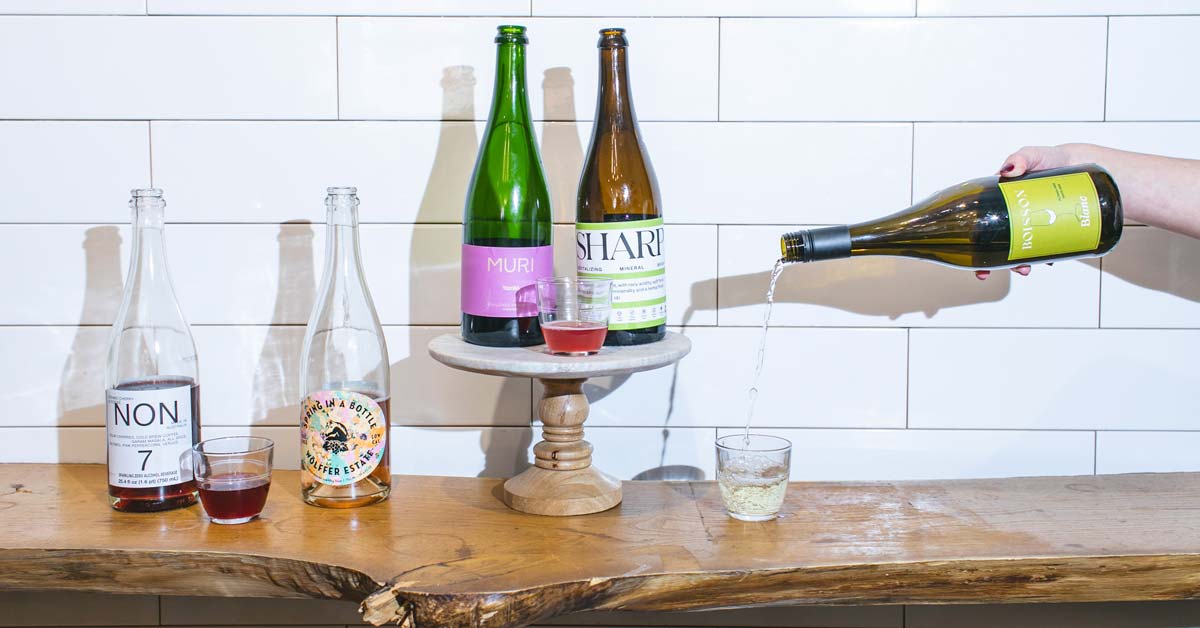No one will be surprised to hear that there’s a bounty of nonalcoholic wines available these days. But standing in front of the wall of them at Boisson, a retailer that specializes in such N/A drinks (wines, spirits, RTD cocktails, etc.), it’s impressive how far we’ve come. The category has grown exponentially in the past few years and encompasses both made-from-grapes wines, in which the alcohol has been removed, as well as an emerging group of bottlings that incorporate a wide variety of ingredients, infusions and nonalcoholic fermentations. Wine accounts for 60 percent of sales at Boisson, Robby Nelson, head of on-premise sales, told me.
At Boisson’s flagship shop in Brooklyn, Punch tasted through a couple dozen nonalcoholic wines and wine alternatives, chosen to span the spectrum of approaches to N/A wine. I was joined by Nikita Malhotra, beverage manager for New York’s Momofuku Ko, along with Punch editor-in-chief Talia Baiocchi, senior editor Chloe Frechette, director of network development Allison Hamlin and associate editor Mary Anne Porto.
According to the FDA, wines that have less than 0.5 percent ABV can be labeled “nonalcoholic” whereas those with 0.0 percent ABV can be called “alcohol-free.” The majority of the more traditional wines we tasted quoted less than 0.5 percent ABV on their labels, an important distinction for those abstaining from alcohol altogether. Also of note: The majority of these N/A bottlings have around 30 calories per serving—a quarter of that in a glass of white wine—and ingredients (preservatives and all) must be listed, noteworthy as this is something many in the traditional wine industry have been advocating for for years.
In general, our group found more to love in the wine alternatives than in the wines where the alcohol had been extracted. In reference to the latter, Baiocchi asked: “Can you make a wine that tastes like where it’s from in this process?” Understandably, probably not. The process of extracting alcohol is rough on a wine—seemingly robbing it of aroma and texture, which is why many had a faceless quality that left us wanting more. One thing that was also uniformly missing was a finish on the palate, something that in wine is achieved via the evaporative quality of alcohol. Without it, we found many fell flat. Nelson told me that sparkling dealcoholized wines are most popular at Boisson, which makes good sense in that the bubbles can give that little uptick in the texture that still N/A wines struggle to achieve.
By contrast, the wine alternatives offer a path that is largely free of comparison, and while some stray too far from the idea of wine to reasonably bear any mention of it on the label, they seem to offer new opportunities for pairing. Many of them incorporate tea (which has tannins, similar to grapes), fruit juices, herbs and spices, and specialized yeasts that ferment without creating alcohol. The best of them offer a new perspective on what we look for in wine (structure, aroma, character). Naturally, there were also some misses: bottles that tasted like kombucha, raw vinegar or healthy juice-bar fare. Others recalled what Frechette described as “Martinelli’s apple juice,” so much so that we began plotting bottlings on a scale between traditional wine and sparkling fruit juice. One conjured Vicks VapoRub or even Barbasol. When a bottling did strike the right chord, however, it could stand in for a ritual drink with its own layered flavors and intrigue. “That’s what I want from this,” said Baiocchi. “Get weird.”

